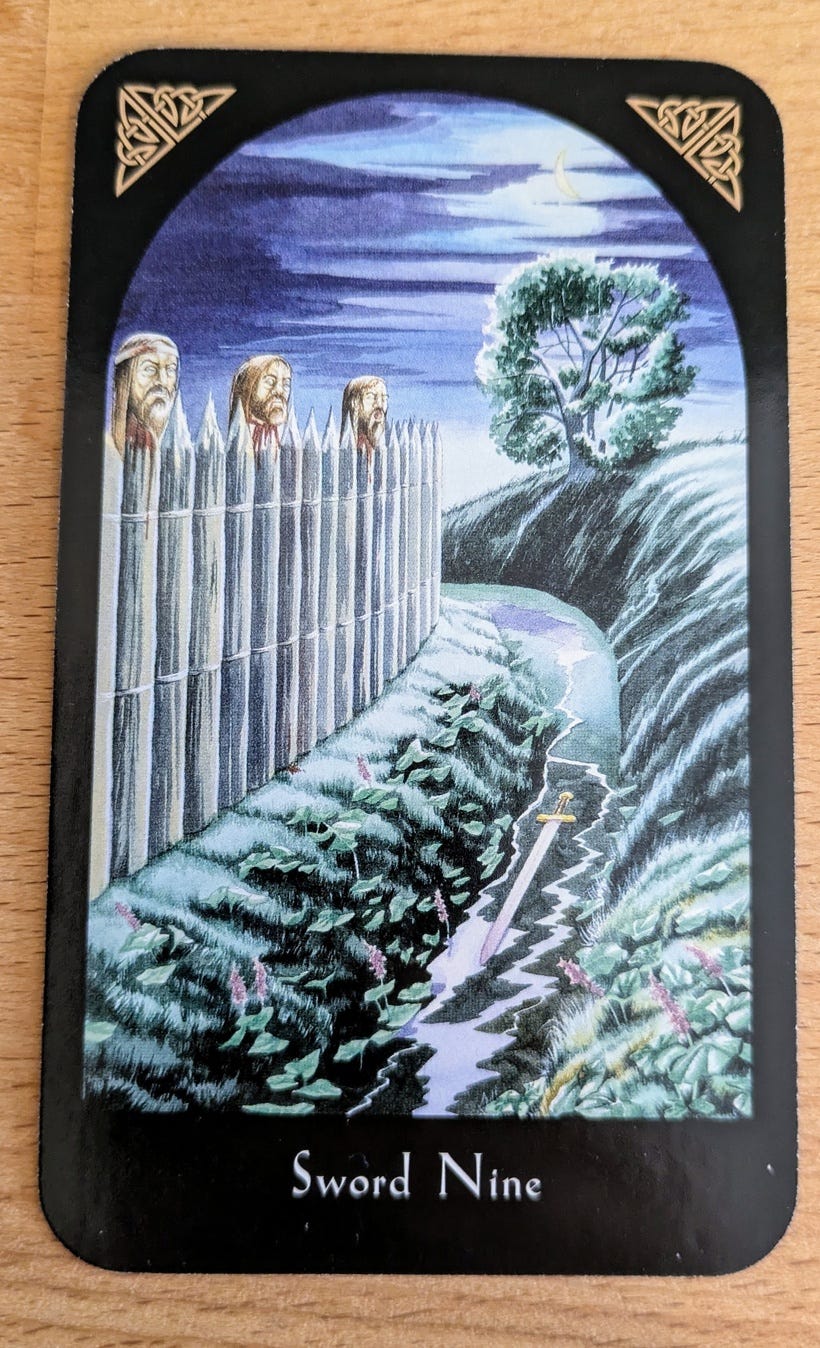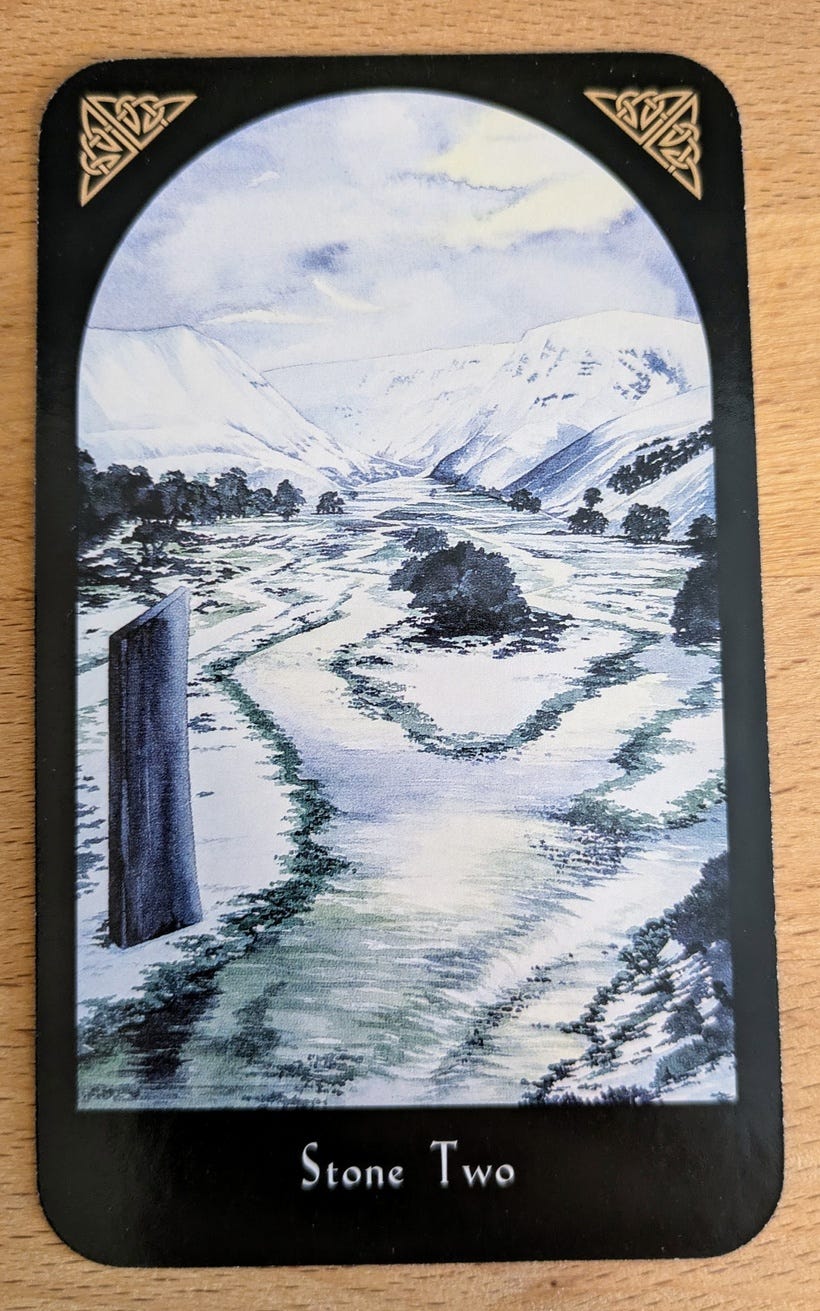This Week’s post pulls some cards for inspiration.
If I'm not careful I can see a future where I own far too many Tarot decks.
Not so much for oracular life guidance, but I'm increasingly drawn to these decks of highly evocative artwork as a means to spark ideas when running or prepping a game.
In the throes of writing Mythic Bastionland I picked up The Complete Arthurian Tarot deck, which is a joy to flick through.
A significant feature of this deck is that (as far as I can tell) the non-Court Minor Arcana are all landscapes, completely devoid of people. This is in stark contrast to the Hanson Roberts Tarot which I have a personal soft spot for. Where the Hanson Roberts deck vividly humanises the elements of the non-Court minors, the Complete Arthurian deck puts the light firmly on the surrounding world.
Take the Grail Three (commonly 3 of Cups).
Commonly this card means party time, with three women toasting and celebrating. Here a vacant table is laid out, allowing more focus on the surroundings. It's a feast of apples in a lush, shady orchard.
The Four normally depicts a man with three cups, either too distracted or jaded to notice the fourth cup being offered to him from a disembodied arm.
Here that's represented by a stagnant pond. Discarded cup and overcast clouds further setting the mood.
8 of Swords is normally a blindfolded, bound woman surrounded in a ring of swords.
Here we're trapped by a treacherous bog instead, requiring careful action to escape. Even beyond that a grey mountain looms over us.
Of course we have to look at everyone's favourite, the 9 of Swords aka "I'm sad because I have too many swords".
This is about as close as we get to human representation. A row of impaled heads painting an ill vision for the future of this shadowy night.
Each suit also corresponds to a season, and that comes through in the artwork to various degrees. Stones (commonly Pentacles) are tied to winter.
In place of the juggler, the concept of divided priorities is shown through a river splitting in two, weaving tantalisingly close to each other through a snow cloaked valley but never managing to converge.
The accompanying book does a good job of tying each of these cards to a particular Arthurian myth, but I enjoy the landscapes even when I don't remember the full mythic context.
So what's the point to all this?
Whether in prep or at the table, for me so much of running Mythic Bastionland is about describing a patch of wilderness as the Knights either ride through it, look over it for landmarks, or come face to face with Omens of a Myth. Sure, it's not the main part of the game, but it's a constant layer of flavour that I try to maintain.
Even if it's not a literal deck of cards, don't neglect the power of a heap of visual prompts to draw from for your game. Sometimes they can be as simple as a landscape.
Elsewhere
Speaking of Tarot cards, Jude’s World is still funding on Kickstarter. 90s, divorce, pulling cards and making stuff up? Sounds good.
Throne of Salt gives resources for generating Mothership adventure locations.
All Dead Generations details the last roost of the beaked god.
Coming Soon
Over on Patreon I’m back into the Mythic Realm.
Mythic Bastionland suggests that Holdings are commonly ruled by a Knight. Last time I spoke about this I had one of the four Holdings in a Realm ruled by a non-knight, in that case a religious leader, but what other sort of person could be ruling a Holding?
Expect the full post here and on the blog next week.
Thanks for reading Bastionland Presser! Subscribe for free to receive new posts straight into your inbox.









Is there such a thing as too many Tarot decks?